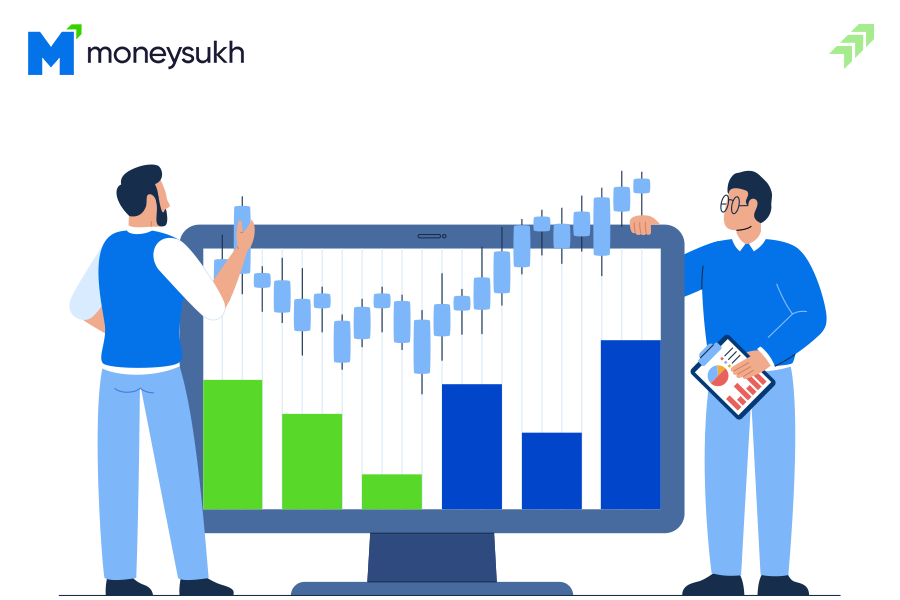In the stock market, there are various forces working behind the movement of stocks during trading hours. Volume is one of the important factors responsible for stock prices moving in the upward or downward direction during a specific period.
Volume in trading shows there are too many buyers and sellers taking interest in the stock and they are making the trade positions into the stock or underlying security as per their perception towards the stock and its trend. Today here,in this article we will discuss about the importance of volume in technical analysis and its use or role in trading.
What is the Volume in Stock Market?
Volume in the stock market world is simply the number of shares or contracts traded in a specific period, usually one day is counted. The higher the volume, it means the trading in stock is highly active and there would be either side movement.
Volume is also shown along with the chart bars and can be visible at the bottom of the charts. And volume illustrates how much quantity of shares have been traded on a particular day and it shows the trend of stock where is being headed.
What is the Use of Volume in Trading?
In trading, volume is used to find out the liquidity in a particular stock. Traders check the average daily, weekly or monthly volume in trading to know whether stocks have sufficient buyers and sellers or not, and then decide what to do.
Mainly, intraday traders always consider the volume before making any long or short position in the stock market, because without volume there would be no movement in the stock and maybe it will not move as per your expectations.
Also Read: How to Do Intraday Trading: Best Stocks, Charts & Strategies
Many times intraday traders pick the stock as per the momentum and that is possible when there will be enough volume in that stock. Volume in trading is important not only in stocks but in the derivatives market or F&O segment, without substantial volume traders do not take any position, as their trade will become ideal due to lack of volume in trading.
Importance of Volume in Trading
With the time being and listing of more shares in the stock market, volume is becoming the key factor, without volume you will not have multiple buyers and sellers of any stock in the market. Volume plays a game-changing role in trading.
Without significant volume in a stock, traders avoid such stock for intraday trading, even for short-term delivery-based trading. As, without volume, there will be la ack of liquidity in that stock resulting in an unexpected move or stock will not have movement. And without proper liquidity in the stock, you cannot find enough buyers or sellers in the market.
Also Read: 7 Biggest Mistakes To Avoid While Doing Intraday Trading
Moreover, when there is movement in any stock or it comes out from its range-bound trend, volume plays an important role. A breakout and breakdown in stocks happen when volume surges more daily average and one side traders either buyers or sellers become dominant resulting they push that stock from its trading range and moving into a new direction.
What is Volume in Technical Analysis?
Traders use technical analysis to decide between buying and selling stocks. It helps them to know whether a stock is likely to move in which direction and also decide the entry and exit points. And volume plays an important role in technical analysis while making such crucial decisions of buying and selling the stocks at the best levels.
Also Read: Difference Between Fundamental Analysis and Technical Analysis
In technical analysis, various tools and techniques like examining the formation of candlestick charts, RSI, Moving Averages, Bollinger Band, and Fibonacci Retracement are used to analyze the stocks technically.
And without significant volume, all these tools and techniques are useless, as they will not be effective and stock price prediction based on these tools without sufficient volume would be not reliable. Stock Breakout & Breakdown is another technique in technical analysis that happens when there is a huge volume in trading.
Also Read: What is Breakout & Breakdown How to Identify Breakout in Stocks
To check the volume, bar charts are analyzed, if these bar charts are higher than average, it means there is strength in the market price of the stock. Here analysts use the bar chart to analyse the volume to make sure the price movement is strong.
In technical analysis, support and resistance are the strong point to enter or exit in any stock. And when there is an increase in the volume at these points, the stock breaks the support or resistance and traders make trading positions in such stocks.
How to Use Volume in Technical Analysis?
Using the volume of trade in technical analysis, you must have the knowledge and experience of correlating the tools and techniques that are effective when there is volume in trade. In technical analysis, volume is not the prime factor but without volume, the trend reversal or breakout and breakdown in stock can be false.
Hence, apart from all the methods that indicate the price movement of stock, volume is another important factor that needs to be considered while buying or selling stocks. Let’s find out below how volume can be used in technical analysis.
Confirm Price Change with Volume: One of the most common uses of volume in technical analysis is, to confirm the price movement in stocks. When the price of a stock increase or decreases, there should be also substantial volume during the period. If price movement is not accompanied by the volume, it means the change in the price of the stock is not sustainable, there might be a trend reversal and the price change may not continue further.
Find the Support & Resistance Levels: As already told you support and resistance are two important points where traders decide to buy or sell the stocks. When a stock reaches the nearest support and resistance, then traders check the volume to decide whether the level is likely to hold or break at this point. If the volume is high there is a chance the level might break, and if the volume is low, the level may be likely to hold at this crucial point.
Using Volume with Moving Averages: Moving Averages are another important technical indicator used by traders in technical analysis. The moving average is the average price stock over a specific period like 20 days, 50 days or 200 days. Traders compare the volume with moving averages to determine whether the stock price movement is supported by volume or not.
Also Read: Technical Indicators that Every Trader should be aware of
Here, if the stock price moves above the moving average and volume increase, it means that the trend is likely to continue further. While on the other hand, if the stock price moves below the moving average and volume decrease, it means the trend is likely to reverse. Comparing the volume with Moving Averages traders make the positions.
Volume Analysis with Divergence: The divergence in the volume of trade when the price of security moves in a single direction while volume is moving in the opposite direction. Let’s make it clear with an example – suppose the price of stock increases but the volume is decreasing, it indicates that the price increase is not sustainable and the price correction is pending.
While on the other hand, analyzing volume with divergence,if the price of the stock decreases, but volume is increasing, it indicates that the price decline is substantial and a trend reversal might be taking place shortly.
Check the Spikes in Volume: The spikes in volume happen, when the volume of stock rapidly increases or decreases. And these spikes can be triggered due to important corporate actions, worthy news events and major collaborations, mergers or demerger announcements by the company. You can analyze the volume spikes to determine whether such actions are likely to have a significant impact on the price of the stock.
Importance of Volume in Technical Analysis
Volume is playing a vital role in technical analysis by using the combination of tools and techniques authenticated with volume in trade. It helps to make sure the trend and chart patterns are going to give the right predictions.
Any kind of stock price movement upward side or downward side with relatively high volume is perceived as a solid and more relevant move compared to a similar move with weak volume. Traders always check the volume along with the other technical analysis tools to make sure the trend is likely to continue or reverse shortly.
Volume indicates the level of liquidity in the stock. A stock having a huge volume means it is highly liquid, while a stock with low volume is not considered liquid that is usually picked for short-selling or while taking positions in future & options trading.
Also Read: What is Short Selling & How Does it Work: Is it Good or Bad
Trading volume in technical analysis is like validating the price movement of stock when there is a breakout, breakdown or trend reversal. And when there is momentum in the stock, the price changes and if trading volume increases, the stock price is likely to move in the same direction.
Role of Volume in Technical Analysis
Volume in technical analysis is playing an important role while buying and selling stocks. From trend confirmation to high liquidity and stock price breakout or breakdown, volume plays a crucial decision while making the right position in the trade.
When the volume of trading surges in any stock, it means there could be a significant in the price of the stock. Let’s find out some of the key role volume plays in technical analysis and trading in the stock market for better returns.
Also Read: Technical Analysis vs Fundamental Analysis: Which is Better
Trend Confirmation: Rising volume with rise in the price of stock means the market is rising and when buyers keep pushing the price, they show high expectations. An increase in the volume of data also encourages buyers more to buy.
Only rising the price of the stock would be not enough, the significant volume in the same gives a strong signal that investors are optimistic. When price increases, along with a decrease in trading volume, it is a warning to investors interested in the market.
Price Reversals: Suppose the price of a stock has progressed in a single direction for a long time that could be a positive or negative price movement. If the price change at a low percentage and volume is very, it means it is a signal of a price reversal in future. Such indication means that the price increasing over the previous long time and now the direction is likely to change in this stock.
Liquidity in the Market: When the volume of trade in the main index is significantly high, it means there is ample liquidity in the market. A market with high trading volumes means liquidity in the market and many buyers and sellers are ready to trade.
Breakouts from the Range bound: If a stock was trading in the range bound market and there is a breakout and the price is moved above that range then volume can be a reliable indicator of the strength of that breakout from the range bound trend.
Signs of Bullish Market: Volume plays an important role to identify the bullish signs in the market. Let’s take an example, suppose a stock price declines, while volume increases. As a result, the price will moveup and then fall again. If the price decreases a second time but not goes lower than the first low, the volume at the time of the second time decline gets reduced. This is considered as the signal of the market in the bullish trend.
Volume Indicator in Technical Analysis
In fact volume act as one of the leading indicators in technical analysis that helps to understand the trends and patterns. This mainly indicates how much stocks are traded in the market at a given period, which helps to understand how traders are perceiving the market.
However, the main use of the volume is that it indicates the price movement of the stock giving the initial signals when the movement of price is going to continue or reverse. For traders, volume is a very useful indicator, and in technical analysis, there are many ways volume works as a good indicator, let’s find out what are those indicators.
Price-Volume Trend Indicator: Volume-price indicator indicates the movement of the direction of price along with the strength of change in price. This indicator is like an on-balance volume (OBV) indicator that measures the cumulative volume and also provides information about the money flow in the market.
On-Balance VolumeIndicator: It is another volume indicator, that calculates the pressure of buying and selling in the market as a cumulative indicator that adds the volume on up days and deducts volume on down days.
Here if the stock moves higher than the previous close, then the entire day’s volume is considered up-volume.And likewise, when the stock ends lower than the previous close, the entire day’s volume is down-volume.
Accumulation/distribution: The accumulation distribution line is a volume indicator that measures, the cumulative flow of money into the stock. This helps to detect positive or negative divergences in price and volume data that signals an advanced warning of future price movement of the stock.
Money Flow Index: This is the kind of movement along with a volume indicator which analyses both price and time of the stock to find out the buying and selling pressure in that stock. It is also known as volume-weighted-RSI, as it also takes account of volume, not like RSI which only incorporates price.
Ease of Movement: It is a type of oscillator in technical analysis that measures how stock can be moved based on average volume trends. The indicator is suitable for stocks that are behaviorally highly volatile in the market allowing the stock traders to forecast trends without worrying about the fluctuations in the market.
Also Read: VIX India: How it Works, Calculated & Used for Share Trading
A high and positive value for EOM indicates that the stock price is increasing with low volume.While negative value designates price falling at low volume. Hence, you can use EOM, as a secondary indicator along with several other indicators like RSI, Moving Averages and others.
Chaikin Money Flow Indicator: It is another important volume indicator that helps to measure the amount of money that flows into the market, which means trading in a particular stock. Chaikin Money Flow adds Money Flow Volume for a period of around 20 or 21 days in back days.
And this indicator oscillates above/below the zero line just like an oscillator. As per the indicator if the closing price is near to the high then more accumulation takes place. Similarly, if the closing price is at the lowest then, more distribution takes place.
Summing-up
Volume is no doubt playing a very important role in technical analysis that’s of course used for trading in the stock market. It provides useful insight into the market’s strengths and direction of movement of price. Moreover, it helps to know the support or resistance and confirm or validate the predictions based on other leading indicators.
Significant volume in trading in stocks regularly shows that it has enough liquidity in the market and is best suitable for intraday trading. Using the volume in technical analysis, traders make more well-versed decisions to select the right stock for trading and generate better profits in day trading or delivery-based short-term trading.
Similarly, there are many tools, techniques and indicators used in technical analysis that are essential for intraday trading. And for that, you have to open a demat account and enjoy intraday trading at the lowest brokerage at Moneysukh.
Also Read: How to Select Stocks for Intraday: 10 Tips to Pic Best Stocks
Moneysukh is one of the leading broking houses in India, offering world-class trading facilities in Equity, Commodity and Currency. Retail investors looking for low-cost trading solutions can get here the best trading plans with intraday tips and short-term and long-term stock recommendations for investors or traderslooking to make money from the stock market.
Also Read: How to Be a Good Investor or Trader to Buy Best Stocks in 2023



















No comment yet, add your voice below!